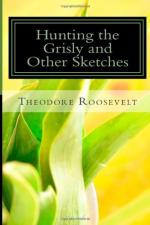Bear are fond of wallowing in the water, whether in the sand, on the edge of a rapid plains river, on the muddy margin of a pond, or in the oozy moss of a clear, cold mountain spring. One hot August afternoon, as I was clambering down a steep mountain-side near Pend’Oreille lake, I heard a crash some distance below, which showed that a large beast was afoot. On making my way towards the spot, I found I had disturbed a big bear as it was lolling at ease in its bath; the discolored water showed where it had scrambled hastily out and galloped off as I approached. The spring welled out at the base of a high granite rock, forming a small pool of shimmering broken crystal. The soaked moss lay in a deep wet cushion round about, and jutted over the edges of the pool like a floating shelf. Graceful, water-loving ferns swayed to and fro. Above, the great conifers spread their murmuring branches, dimming the light, and keeping out the heat; their brown boles sprang from the ground like buttressed columns. On the barren mountain-side beyond the heat was oppressive. It was small wonder that Bruin should have sought the spot to cool his gross carcass in the fresh spring water.
The bear is a solitary beast, and although many may assemble together, in what looks like a drove, on some favorite feeding-ground—usually where the berries are thick, or by the banks of a salmon-thronged river—the association is never more than momentary, each going its own way as soon as its hunger is satisfied. The males always live alone by choice, save in the rutting season, when they seek the females. Then two or three may come together in the course of their pursuit and rough courtship of the female; and if the rivals are well matched, savage battles follow, so that many of the old males have their heads seamed with scars made by their fellows’ teeth. At such times they are evil tempered and prone to attack man or beast on slight provocation.
The she brings forth her cubs, one, two, or three in number, in her winter den. They are very small and helpless things, and it is some time after she leaves her winter home before they can follow her for any distance. They stay with her throughout the summer and the fall, leaving her when the cold weather sets in. By this time they are well grown; and hence, especially if an old male has joined the she, the family may number three or four individuals, so as to make what seems like quite a little troop of bears. A small ranchman who lived a dozen miles from me on the Little Missouri once found a she-bear and three half-grown cubs feeding at a berry-patch in a ravine. He shot the old she in the small of the back, whereat she made a loud roaring and squealing. One of the cubs rushed towards her; but its sympathy proved misplaced, for she knocked it over with a hearty cuff, either out of mere temper, or because she thought her pain must be due to an unprovoked assault from one of her offspring. The hunter then killed one of the cubs, and the other two escaped. When bears are together and one is wounded by a bullet, but does not see the real assailant, it often falls tooth and nail upon its comrade, apparently attributing its injury to the latter.




